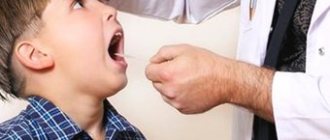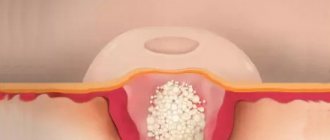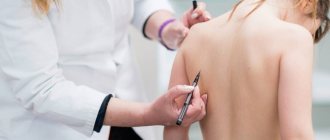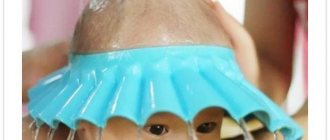For what disorders are these procedures prescribed and how are they carried out?
Electrophoresis according to Ratner (with aminophylline and papaverine):
- Circulatory disorders in the cervical spine
- Injuries and hypoxia during pregnancy and childbirth
- Torticollis
- cerebral palsy
- ZPR
- Specific disorders of speech development (especially effective in combination with speech therapy massage and speech therapy classes)
Electrodes are applied at the back in the cervical-collar area, at the front on the right side of the chest. Exposure time 15-20 minutes. The number of procedures is 10-14.
Electrophoresis with magnesium:
- Increased excitability of the nervous system
- ADHD
- Sleep disturbance
- Astheno-neurotic syndrome
- Tiki
- Stuttering
- Autonomic dysfunction
- Headache
Electrodes are applied at the back in the cervical-collar area. Exposure time 15-20 minutes. The number of procedures is 10-14.
Electrophoresis with an antispasmodic on the lower extremities:
- Cerebral palsy spastic form
- “Tiptoes” (the child often walks, resting only on the front of the foot)
- Flat valgus foot
Electrodes are applied to the calf muscles. Exposure time 15-20 minutes. The number of procedures is 10-12.
Physiotherapy. What it is?
Physiotherapy is the influence on the body using various physical factors - both natural and artificially created. These factors include phenomena such as magnetic fields, currents, ultraviolet radiation, light, heat, air, ultrasound and many others. All these methods of influence are relatively harmless compared to, say, drug therapy and help the body activate its own healing mechanisms. Physiotherapy can be both the main method of treatment for some diseases, and an additional element of the main course of treatment. Physiotherapy for children is used more often than for adults, since the children's body is more sensitive and requires careful intervention.
How is the therapeutic effect of physiotherapy achieved?
The therapeutic effect of physiotherapy is determined by the activation of certain receptor fields in the body, which in turn stimulates the process of self-healing. The various physical factors mentioned above are capable of generating specific processes in tissues and organs. Depending on the area of damage and the purpose of physiotherapeutic procedures (treatment, prevention or rehabilitation), each patient is prescribed a strictly defined course, which prescribes not only the number of procedures, but also the area and intensity of the impact. This takes into account the individual characteristics of the human body, contraindications and other possible side effects. By the way, side effects from physiotherapy are extremely rare and can only be caused by the unprofessionalism of the physiotherapist and pediatrician.
What are the advantages of this drug administration regimen?
- Minimal number of side effects, because the drug enters the body bypassing the digestive tract
- Local exposure with a high concentration of the substance helps deliver the medicine directly to the pathology area without saturating the entire body
- The procedure is painless and non-invasive; during the procedure the patient does not experience pain, there is no damage to the skin and mucous membranes
- Prolonging the effect of a medicinal substance, creating a kind of “depot” with a drug in the skin, which provides a long-lasting therapeutic effect and allows you to reduce the dosage of the drug
- The effect of the drug is enhanced by direct electric current
- The effectiveness of other non-drug treatment methods used in the Prognoz clinic is increasing.
The effectiveness of electrotherapy
Electric current has a variety of useful properties and is used in the form of various techniques. Electrophoresis is one of the most popular and effective methods in the treatment of infants. The method consists of using a weak electric current and low voltage. Additional use of medicinal solutions allows you to achieve a positive result in a shorter period of time and increase its duration.
The use of electrophoresis is based on the breakdown of the drug into ions that pass through the skin and mucous membranes into the pathological focus.
The irritating effect of current and medicinal substances on skin receptors transmits an impulse to the brain, thereby regulating the action of the entire body. Medications have a local effect, practically not being absorbed into the bloodstream, which allows them to be used in the treatment of children.
Electrophoresis activates metabolic processes, improves tissue regeneration, and has a resolving effect. The production of adrenaline, histamine, prostaglandin in tissues also increases, nerve conduction increases, muscle tone and permeability of the vascular wall decreases, swelling and inflammation in the pathological focus decreases. Improving cell nutrition stops the progression of atrophy and sclerotic processes in tissues and organs.
Electric current stimulates the restoration of the function of damaged motor fibers and their functional state, accelerates blood circulation, microcirculation and lymphatic drainage, reduces thrombus formation and lymphostasis. Electrophoresis regulates the functioning of all parts of the brain through the autonomic nervous system, affects organs and tissues, removes toxins and reduces pain. Studies show that medicinal substances administered using electrophoresis remain in the skin for up to 3 weeks and have a long-term effect on the pathological focus.
Physiotherapy treatment methods
Physiotherapy treatment methods are extremely varied, but they are all divided into two main categories - hardware methods and methods using natural physical factors. Let's look at each of these categories in more detail.
Physiotherapy using natural physical factors
Natural methods in physiotherapy include water treatments (balneotherapy and thalassotherapy), mud therapy (peloid therapy), heat therapy, movement and breathing exercises, massage and massage-like techniques, air (heliotherapy) and sunbathing and much more.
Hardware physiotherapy
Among hardware physiotherapeutic methods, the leading areas are electrotherapy, magnetic therapy and phototherapy. Electrotherapy is divided into procedures depending on the type of influence chosen - low-voltage direct currents, alternating currents, electric field. There are two types of magnetic therapy – variable low-frequency and high-frequency. The main types of phototherapy use infrared, ultraviolet and visible radiation (color therapy). Let us consider in more detail some types of hardware physiotherapeutic procedures:
- Low-frequency pulsed electrotherapy
produces sinusoidal modulated low-frequency currents. Such currents stimulate muscles and nerves, which is especially useful for improving the condition of the muscular system, restoring diseased or damaged nerve fibers, and also for losing weight. The procedure helps improve metabolic processes - this determines its effect; - UHF, or inductothermy
, is exposure to an ultra-high frequency electromagnetic field. The peculiarity of the effect is that it easily penetrates all tissues of the body, warming them up, improving blood supply and providing anti-inflammatory, decongestant, analgesic, antispasmodic effects. UHF helps improve the functioning of the immune system, helping it fight pathogenic microorganisms. UHF procedures are indicated for inflammatory diseases of the musculoskeletal system, respiratory organs, acute inflammatory processes of the skin, and diseases of the peripheral nervous system; - Infrared light therapy
is an effect that penetrates tissue to a depth of 2–3 cm, stimulating the self-healing of damaged tissue, relieving spasms and pain, and improving tissue metabolism. Infrared phototherapy is indicated for diseases such as bronchitis, pneumonia, arthritis, neuritis and others. Phototherapy using ultraviolet light is used for increased vascular permeability, bone demineralization, caries and rickets in children; - Darsonval
is a procedure for influencing the body with pulsed alternating currents of high frequency and voltage. Darsonval is usually used for local effects that irritate the nerve receptors of the skin and mucous membranes. Indications for use: diseases of the ENT organs, some dental diseases, psoriasis, dermatoses, vascular diseases.
As can be seen from the above, physiotherapeutic procedures are used to treat colds and skin diseases, diseases of the musculoskeletal system, gastrointestinal tract, nervous and cardiovascular systems. Many physiotherapeutic procedures are also widely used not only in treatment, but also in rehabilitation after serious illnesses, as well as in the prevention of diseases of the spine and respiratory system.
Physiotherapy at home
Most physiotherapeutic procedures using natural physical factors can be carried out at home, as well as some hardware methods of physiotherapy - using modern compact equipment.
Massage is the most common procedure. Children's massage can be healing and therapeutic. Wellness massage helps strengthen weakened children, and therapeutic massage helps to cope with specific diseases. Starting from 1.5 months, a healthy child can already undergo general massage and therapeutic exercises (strictly on the recommendation of a doctor). Depending on the existing abnormalities, the child may be prescribed a massage of a certain part of the body - for example, head massage, leg massage, back massage, foot massage, etc.
For children under one year old, massage will help avoid digestive problems, regular colds, strengthen the musculoskeletal system, improve metabolism and normalize sleep. In older age, massage will help cope with diseases such as cerebral palsy, malnutrition, rickets, constipation and problems with the spine. It is better to carry out massage for children in a specially equipped children's clinic, which has all the necessary conditions and employs experienced specialists. Parents can also perform some baby massage techniques at home - but only the simplest ones, and only after appropriate training.
Indications for electrophoresis with aminophylline
For the procedure, aminophylline is used in solution. If we talk about the advantages of this particular method of drug delivery:
- the medication is delivered to the desired location in an active state;
- delivery is targeted to a specific focus of the disease, which reduces unnecessary effects on the entire body;
- With this method of transportation, the substance tends to accumulate and thereby increase the duration of its effect.
Electrophoresis with aminophylline is indicated in the following cases:
- Bronchial asthma.
- Impaired muscle tone (muscle spasms).
- Hypertonic disease.
- Diseases of the large intestine.
- Spinal diseases: osteoarthritis, osteochondrosis, Schmorl's hernia.
- Poor circulation in the kidneys and brain.
- Psoriasis.
- Scleroderma.
- Diseases of the pelvic organs.
- Lymphadenitis.
- Chronic obstructive pulmonary disease.
- Tracheitis.
- Furunculosis.
- Bedsores.
- Some diseases of the nervous system.
How it works
Depending on the disease, technique, and frequency of procedures, the body’s reaction can be local or general. In general, after a course of procedures you can expect:
- reduction or relief of pain, resorption and softening of scars;
- healing, acceleration of regeneration of nervous tissue in diseases of the PNS;
- improvement of cellular nutrition in diseases of the musculoskeletal system;
- regulation of autonomic functions in rhinitis, bronchial asthma, migraine;
- improved hemodynamics, with heart contractions becoming less frequent;
- regulation of secretory and motor functions of the gastrointestinal tract.
Indications for use
Register your child for a medicinal electrophoresis procedure at the On Baby Clinic for the following pathological conditions and diseases:
- injuries and fractures of bones, musculoskeletal system;
- consequences of traumatic brain injury;
- chronic and acute inflammatory processes in organs and tissues;
- injury or disease of the nervous system (CNS, PNS) of toxic, infectious, traumatic origin;
- neurotic conditions, infectious-allergic and traumatic neuritis;
- hypertension, hypotension, cardiovascular diseases;
- injuries and diseases of the spinal cord, cerebrovascular accidents;
- consequences of tick-borne meningoencephalitis;
- neuralgia of the trigeminal, glossopharyngeal, occipital nerves.










